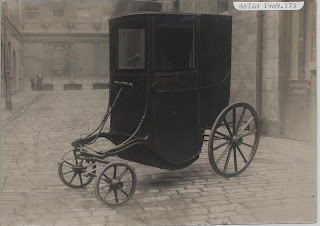As part of
my volunteering in the collections department, I was given the opportunity to
write a blog about any artefact in the Roman Baths collection. Although I was
initially overwhelmed by the choice of interesting objects, I soon came across
an intriguing collection of 7 lantern slides featuring the palace of Versailles.
Lantern slides are photos printed onto glass and projected using light. They
have been around for hundreds of years, and before photography was discovered
they were made by hand painting an image onto glass. These slides were donated
to the Roman Baths in 1989 by a Miss Garraway.
 |
| Lantern slide of La salon de guerre at Versailles |
Le Petit Trianon was given to Marie Antoinette in 1774
when she married Louis XVI of France. It already included a small castle
surrounded by gardens that Louis XV had been developing since the 1750s.
 |
| Lantern slide of le temple d'amour |
Marie
Antoinette dramatically changed the gardens of the Le Petit Trianon, commissioning the architect Richard Mique to
redesign them to her taste. She was responsible for the addition of the Love monument as well as
The Queen’s Hamlet, a small village of 10 buildings that included a working
farm and dairy. It is widely believed that the Queen would amuse herself by
pretending to be a farmer here, but really the Hamlet was used for hosting
guests and educating the royal children. Unfortunately, there is not a photo of
the Hamlet in Miss Garraway’s collection, although I did find a Braun photo of
the Hamlet online.
Miss
Garraway donated lots of items to the museum in 1989, including an Egyptian mud
brick, a flint arrowhead and a total of 120 glass lantern slides. On a trip to
the Record Office, we found that the collection had belonged to her father, who
was headmaster at St. Saviour’s school.
 |
| A Bath Chronicle article about Mr Garraway, 1st November 1947 |
It is still unclear why these
artefacts were in his possession. It is
possible that he used these items in his school to help educate children. The
fact that the photographer Braun was known for using contemporary methods to
market his pictures worldwide does explain how the Garraways were able to
access these photos.
Ella
Volunteer






















